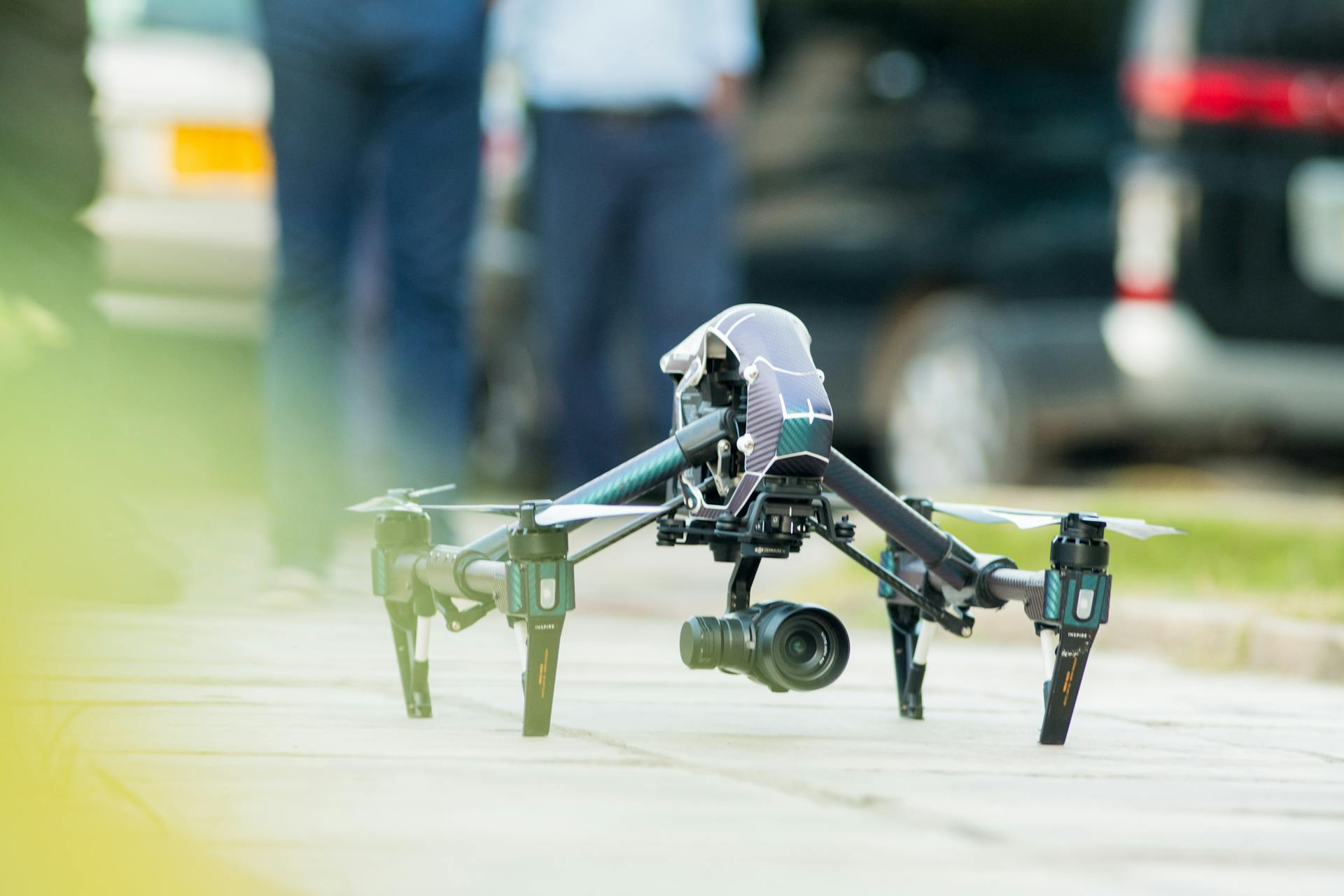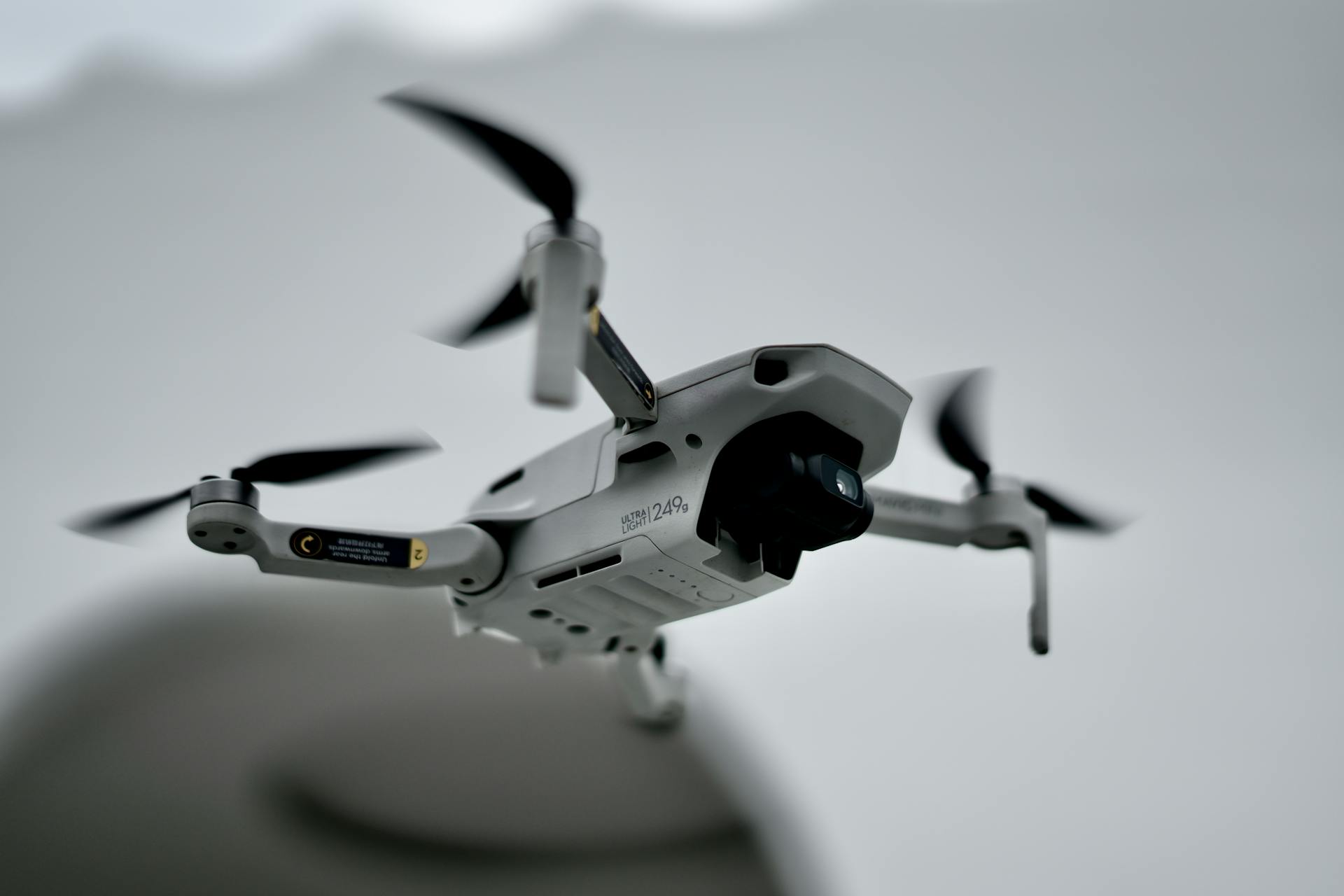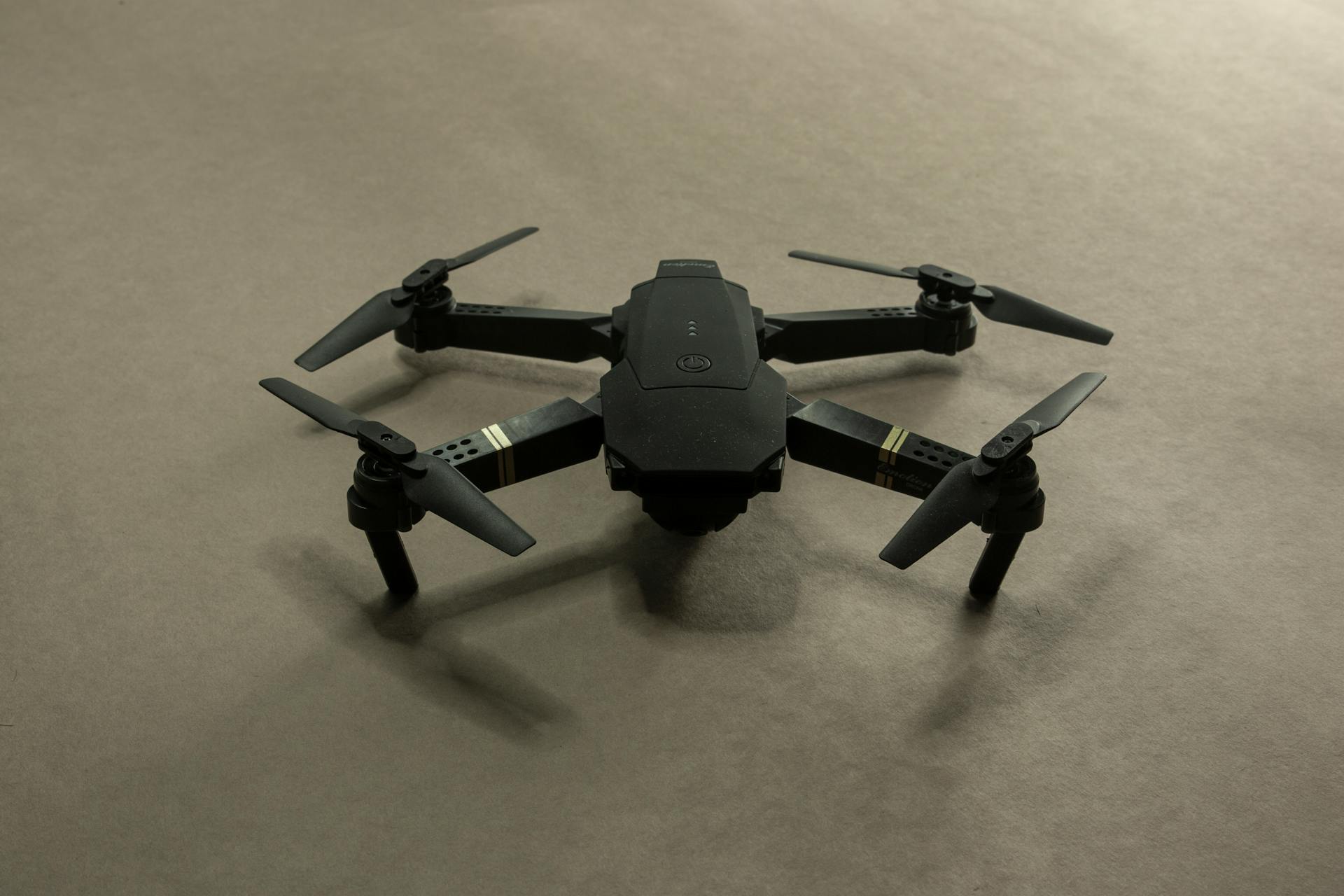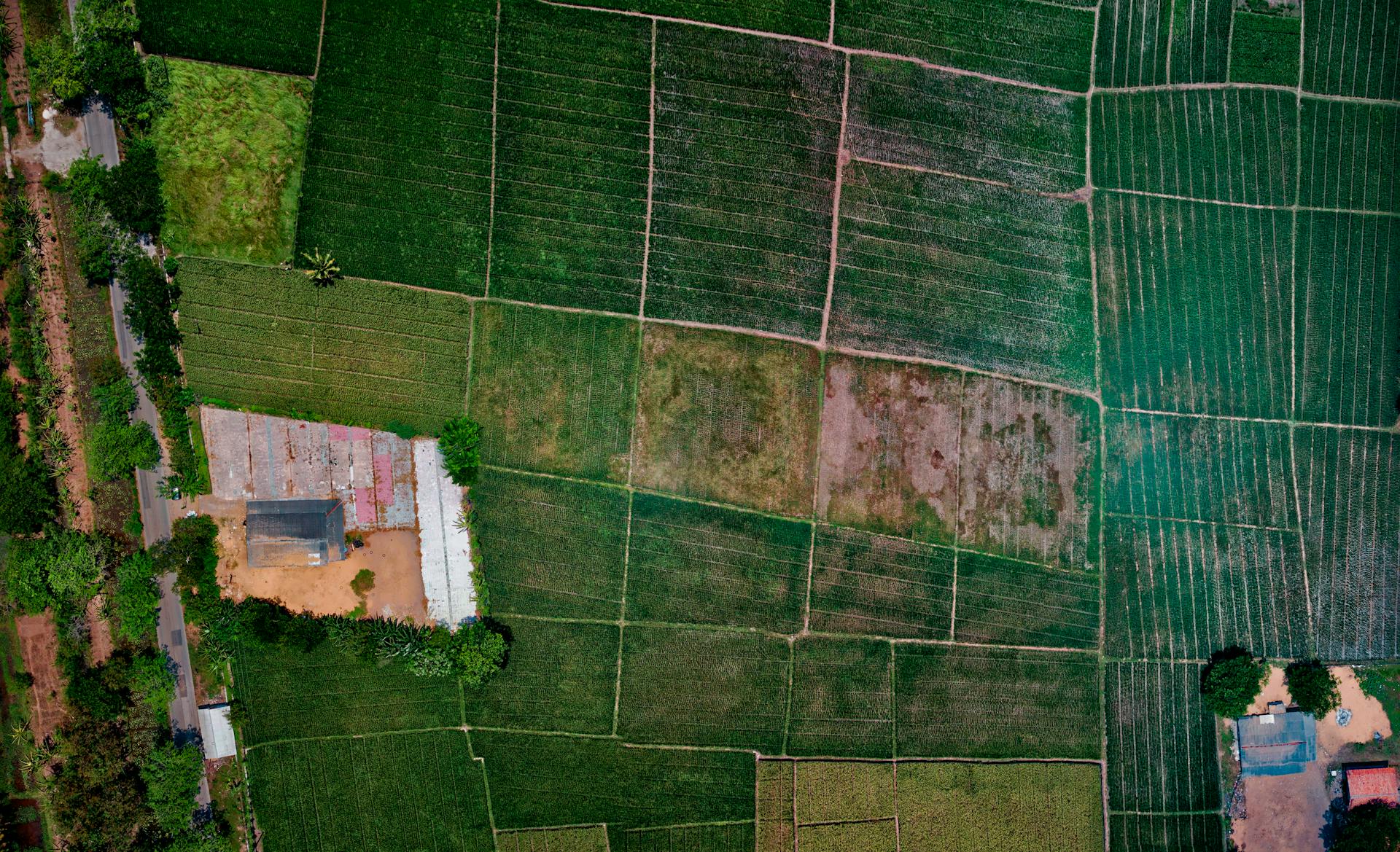
Drones for home security can provide an added layer of protection and peace of mind for homeowners. They can be equipped with high-resolution cameras and sensors to detect and deter potential intruders.
Homeowners can expect to spend anywhere from $200 to $1,000 on a drone, depending on its features and capabilities. Some drones are designed specifically for home security, while others can be repurposed for this use.
Drones can be programmed to patrol your property at set times, providing a constant surveillance presence. This can be especially useful for homeowners who live in areas with high crime rates or who have valuable possessions that need extra protection.
In addition to surveillance, some drones can also be equipped with loudspeakers to scare off potential intruders. This feature can be a valuable addition to a home security system.
Consider reading: How Can Drones Improve Security
Key Features and Capabilities
Drones for home security offer a range of key features and capabilities that make them an attractive option for homeowners.
High-resolution cameras allow for clear video feed, enabling users to monitor their property in real-time. This is particularly useful for keeping an eye on pets or valuables.
Some drones come equipped with night vision capabilities, extending their surveillance capabilities into the evening hours.
Motion detection alerts homeowners to potential security breaches, allowing for swift action to be taken.
Drones can be programmed to patrol specific areas of the property, ensuring that all regions are covered.
With some drones, live streaming is possible, enabling homeowners to share the feed with family members or law enforcement if needed.
Technical Components
For a home security drone to fly smoothly and capture high-quality images, you'll need a solid technical foundation. A lightweight and durable micro-drone frame made of carbon fiber or high-strength plastics is essential for stability and maneuverability.
The flight controller is the brain of the drone, processing sensor data and issuing commands to the motors for stable flight. A dedicated Power Management Unit (PMU) regulates the power supply to the flight controller and other onboard electronics, preventing damage from power surges.
Recommended read: Military Drone Controller
The flight controller also relies on a high-capacity Lithium Polymer battery, which provides sufficient power for approximately 10 minutes of flight time. A small, high-resolution camera with Wi-Fi capabilities is also necessary for image capture and real-time transmission to the control system.
Here are the essential components of a smartphone flight controller:
- Micro-drone Frame: Carbon fiber or high-strength plastics
- Brushless Motors: High-efficiency motors for desired flight times and maneuverability
- Battery: Lithium Polymer, 10 minutes of flight time
- Power Management Unit (PMU): Regulates power supply to flight controller and other electronics
- Camera: Small, high-resolution, Wi-Fi capable
- Wi-Fi Module: Enables real-time image transmission
Quiet Operation
Quiet Operation is a key feature in modern drones, especially those designed for security purposes.
New drones include vibration dampening and brushless motors, which significantly reduce noise levels.
These design elements cut the noise levels to roughly half of what other drones produce, providing a clear advantage in monitoring situations.
This reduction in noise is particularly beneficial when monitoring intrusions at or around a facility, allowing for more discreet and effective surveillance.
Flight Components
When building a micro-drone, selecting the right flight components is crucial for stable and efficient flight. A lightweight and durable frame, such as one made from carbon fiber or high-strength plastics, is essential.
The frame should be paired with high-efficiency brushless motors, which provide the necessary power for desired flight times and maneuverability. A lightweight, high-capacity Lithium Polymer battery will provide sufficient power for approximately 10 minutes of flight time.
A Power Management Unit (PMU) is necessary to regulate the power supply to the flight controller and other onboard electronics, ensuring stable voltage and preventing damage from power surges. Additionally, a dedicated Integrated Circuit (IC) provides real-time monitoring of the battery voltage and current, crucial for estimating remaining flight time and triggering low-battery warnings.
Here are some key components to consider:
- Micro-drone Frame: Carbon fiber or high-strength plastics
- Brushless Motors: High-efficiency for desired flight times and maneuverability
- Battery: Lightweight, high-capacity Lithium Polymer for approximately 10 minutes of flight time
- Power Management Unit (PMU): Regulates power supply to the flight controller and other onboard electronics
- Integrated Circuit (IC) for Battery Monitoring: Real-time monitoring of battery voltage and current
A small, high-resolution camera with Wi-Fi capabilities is essential for image capture, while a Wi-Fi Module enables real-time image transmission from the camera to the control system.
See what others are reading: Military Drone with Camera
Building and Programming
Building and programming a micro-drone requires careful attention to detail. This involves assembling the hardware components and configuring the flight controller software.
The flight controller acts as the brain of the micro-drone, processing sensor data and issuing commands to the motors for stable and autonomous flight. It's essential to select a high-quality flight controller that can handle the demands of autonomous flight.
A different take: Drone Remote Controller
To define the autonomous flight path within the home environment, you'll need to use flight planning software. This software will help you plan a safe and efficient flight path that avoids obstacles and ensures complete coverage.
Image recognition software is also crucial for detecting changes in the home environment. This software needs to be trained on a set of baseline images of the empty home to establish a reference point for detecting changes.
Here are some key safety considerations to keep in mind:
- Weight and Power Limitations: Micro-drones are lightweight and pose minimal physical threat in a controlled environment.
- Flight Path Planning: The AI autonomous flight path should be able to learn the places of furniture, electronics, and other obstacles to avoid collisions.
- Battery Life and Charging: The drone's flight time needs to be carefully monitored to ensure it returns to the charging station before battery depletion.
- Data Security: Wi-Fi connections and cloud storage for images should be password protected and securely managed.
Base Station: Charging & Data
Our base system is powered by Rust language, a secure and memory-safe server that provides all the necessary functionality.
The base station features a dedicated charging station with a docking mechanism, ensuring efficient charging and secure storage of the drone between flights.
A charging station with sensors can detect missing drones, providing an added layer of security.
The system also includes an alert system that will notify the homeowner through email or text message in case of significant changes detected in the images or if the drone goes missing from the charging station.
Software and Functionality
Our drones for home security system relies on sophisticated software to ensure a safe and secure experience. The system uses a custom Rust server software running in the base station.
The software features a flight planning component that uses AI/ML learning algorithm to program the drone's flight path within the home environment, ensuring complete coverage and collision avoidance.
Here are some key features of the software:
- Flight Planning Software: programs the drone's flight path using AI/ML learning algorithm
- Image Recognition Software: analyzes captured images and compares them to baseline images for object recognition
- Automatic Image Upload: uploads captured images to a private YouTube channel accessible only to the homeowner
This software is designed to provide a comprehensive security solution for homeowners, with features that enhance safety and convenience.
Low Light Operations
The introduction of FLIR and other night vision imaging utilities has removed the limitation of after dark surveillance for security teams.
Competitively priced drones come equipped with night vision optics, allowing facility security to monitor darkened areas from a fixed location.
These advancements have made it possible to maintain continuous surveillance even in low-light conditions.
Security teams can now effectively monitor their surroundings around the clock, thanks to the availability and affordability of night vision technology.
Worth a look: Surveillance Drones What Do Drones Look like at Night
Software and Functionality
The software and functionality of our drone system is designed to provide a comprehensive and secure home monitoring experience.
We'll be using flight planning software to program the drone's flight path within the home environment, which will utilize AI/ML learning algorithms to ensure complete coverage and collision avoidance.
The drone will capture images of the home, which will then be analyzed by image recognition software. This software will compare the captured images to baseline images taken when the home is unoccupied, triggering alerts if significant changes are detected.
The captured images will be automatically uploaded to a private YouTube channel accessible only to the homeowner.
Our custom Rust server software will run in the base station, providing a robust and efficient platform for the system's functionality.
Here are some key features of our software and functionality:
- Flight planning software with AI/ML learning algorithm for collision avoidance
- Image recognition software with object recognition capabilities
- Automatic image upload to a private YouTube channel
Benefits and ROI
The benefits of using drones for home security are numerous, and one of the most significant advantages is the potential for a positive return on investment. In fact, over 90% of companies that use drones for security purposes report a positive return on their investment within just one year.
Drones can help reduce the time required for data analysis and the resources needed to complete security-related tasks, allowing security managers to be more productive and efficient. This can lead to significant cost savings, with some companies reporting a reduction of nearly five times their security costs in just one year.
The market for commercial drones is expanding rapidly, with safety and security-related drone sales expected to double by the end of 2019. This increased awareness and adoption of drones is likely to continue, with projections suggesting that surveillance-based drone investments will increase four times by 2022.
Return on Investment
The Return on Investment (ROI) of using drones for security purposes is a compelling story. Over 90% of respondents who have a stake in their company's security concerns saw a positive return on their drone investment within one year of initial purchase.
The global market associated with commerce applications is a staggering 100 billion dollars, and security is a significant segment, occupying the fourth slot behind infrastructure, agriculture, and transport. This is a testament to the growing demand for drone-based security solutions.
Security managers are finding that drone programs for surveillance have reduced costs of security needs by nearly five times in as little as one year. This is a significant reduction in resources required to complete any security-related assignment.
The market for safety and security-related drone sales is expected to double by the end of 2019, even excluding military use. Projections for surveillance-based drone investments are expected to increase four times by 2022.
The confidence in ROI is further enhanced by the expanding awareness of the benefits and capabilities of commercial drones, which can be merged into established surveillance systems to provide precise security data.
Benefit of Using
Using drones for home security can offer faster response to incidents, real-time situational awareness, and live video feeds to remote stakeholders.
A fleet of drones can be programmed to launch from their nests, run repeated missions, capture aerial footage, and return to their nests to charge and prepare for the next mission.
The global market associated with commerce applications is well over 100 billion dollars, and security currently occupies the fourth slot behind only infrastructure, agriculture, and transport.
Within organizations that use drones for security purposes, over 90% of respondents saw a positive return on their drone investment within one year of initial purchase.
Drones can reduce the time required for data analysis and resources needed for security-related assignments, resulting in a significant reduction of costs.
It is estimated that safety and security-related drone sales will have doubled by the end of 2019, even with the exclusion of UAVs associated with military use.
Drones can be easily adopted for security use cases with platforms like FlytBase, which enables autonomous drone operations, real-time video streaming, and storage.
Security stakeholders can leverage the power of autonomous drones and revolutionize their approach to security management with comprehensive solutions from FlytBase.
Frequently Asked Questions
How much does the Ring drone cost?
The Ring Always Home Cam drone costs $249. This compact drone is designed for home security and surveillance.
Sources
- https://www.dartdrones.com/security-drones/
- https://nextech.online/surveillance-security/
- https://zoewave.medium.com/autonomous-home-security-micro-drone-df989ea02075
- https://www.flytbase.com/blog/drones-for-security
- https://www.theverge.com/2021/9/28/22692048/ring-always-home-cam-drone-amazon-price-release-date-specs
Featured Images: pexels.com


